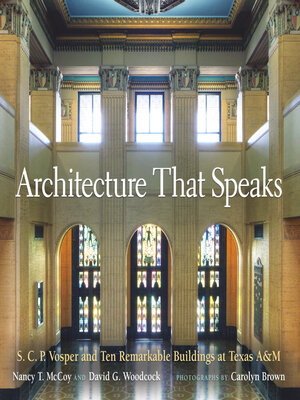Architecture That Speaks
ebook ∣ S. C. P. Vosper and Ten Remarkable Buildings at Texas A&M · Centennial Series of the Association of Former Students, Texas A&M University
By Nancy T. McCoy

Sign up to save your library
With an OverDrive account, you can save your favorite libraries for at-a-glance information about availability. Find out more about OverDrive accounts.
Find this title in Libby, the library reading app by OverDrive.



Search for a digital library with this title
Title found at these libraries:
| Library Name | Distance |
|---|---|
| Loading... |
When the A&M College of Texas opened its doors in 1876, its early buildings followed a Victorian architectural style. Classical architecture came to the campus with the Academic Building, after the 1912 fire that destroyed Old Main. Subsequent buildings generally followed this neoclassical path, but the growth of the campus in the Depression era saw the addition of an extraordinary group of buildings, sited in accordance with a master plan developed by college architect F. E. Giesecke and designed by S. C. P. Vosper, each of whom also held faculty positions in the first architecture program at a state college in Texas.
The buildings designed by Vosper are arguably the finest buildings on the campus, uniquely expressive of the agricultural and mechanical origins of the university; they delight the senses with color, sculpture, and wit. Nancy T. McCoy and David G. Woodcock, distinguished preservation architects and scholars, review the history of Texas A&M campus architecture and provide in-depth coverage of Vosper and his legacy. Illustrated by the sumptuous photography of Carolyn Brown, Architecture That Speaks concludes with observations on recent approaches toward the reuse and rehabilitation of campus heritage architecture and a view to the future, as plans evolve for further development of the campus that maintains a respect for both strategic vision and historical heritage.
The buildings designed by Vosper are arguably the finest buildings on the campus, uniquely expressive of the agricultural and mechanical origins of the university; they delight the senses with color, sculpture, and wit. Nancy T. McCoy and David G. Woodcock, distinguished preservation architects and scholars, review the history of Texas A&M campus architecture and provide in-depth coverage of Vosper and his legacy. Illustrated by the sumptuous photography of Carolyn Brown, Architecture That Speaks concludes with observations on recent approaches toward the reuse and rehabilitation of campus heritage architecture and a view to the future, as plans evolve for further development of the campus that maintains a respect for both strategic vision and historical heritage.







